► CAR magazine’s first Jaguar XE group test
► XE battles BMW 4-series, Mercedes C-class
► Can it banish memories of the X-type?
Forget the X-type, the made-over Mondeo that was supposed to take Jaguar to 300,000 units a year but struggled to sell half its predicted volumes. This time Jag is taking things seriously. Based on a cut down version of the new XF’s platform, the rear- (and eventually four-) wheel drive XE is powered by a brand new range of engines, features fancy double-wishbone front suspension and a body made almost entirely from aluminium. It has a new multimedia system, the first electric power steering Jag has deemed worthy of putting in a production car and sophisticated traction management to deal with snowy conditions. Like we said, forget the X-type.
But even with an arsenal like that the new Jaguar XE has got its work cut out, both in the showroom and up here in the mountainous Basque region of northern Spain. Mercedes’ new C-class has completely shaken the sector up by refocusing on comfort and luxury. A proper junior S-class, it’s the only car in the class to offer air-sprung suspension. And let’s not forget the 3-series. A sales titan, it’s got every angle covered, but always with an eye on handling over luxury. For this test though, we picked its 4-series Gran Coupe brother. Fractionally sharper in style and dynamic terms, its lift-back boot gives it a practical advantage over the 3-series, but most of what we’ll be talking about here applies to the 3-series too.
XE vs 3-series vs C-class: the diesel heartland
These are heartland company cars. Jaguar has been surprised by early demand for the 197bhp and 237bhp 2.0 petrols (there’s a punchy 335bhp 3.0 supercharged V6 from the F-type available too), but although there’s uncertainty over the future of oil burners in the UK’s new NOx-conscious climate, diesel, and the low CO2 numbers it allows, is still king. When picking an XE that means a choice between 161bhp and 178bhp versions of Jag’s new Ingenium engine family, and six-speed manual or eight-speed ZF auto transmissions. XEs start at less than £27,000, but mating the quicker diesel with the auto ’box and racey-looking R-Sport trim bumps that to £34,775. Its opposite number from Mercedes is the £34,770 168bhp C220 BlueTEC in AMG Line trim, while BMW has fielded the 420d M Sport, which delivers 187bhp for £37,185 – a steep £3720 more than you’d pay for the mechanically equivalent, if more spartan 3-series saloon.
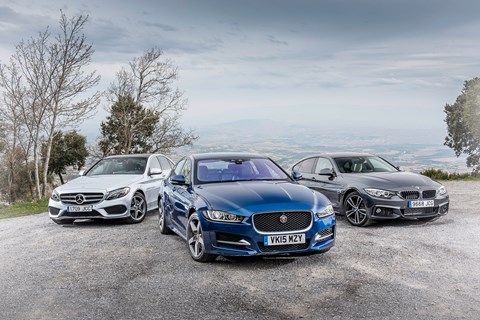
Ironically, it’s the least expensive car that really oozes that premium feel. The C-class isn’t universally handsome. The rear looks a little droopy and the profile, with the interior shifted so far backwards it makes a Bugatti Royale look like a 1990s cab-forward Chrysler concept car, is plain odd. But the three-quarter angles are gorgeous and this car’s diamond silver paint highlights every single nuance of the design, the coving in the doors and contours of the AMG Line bumpers with their faux mesh inserts, and entirely fake twin tailpipes (the real pipe is a limp, downturned single skulking under the boot floor).
The Jag’s dowdy dark blue is less flattering but brighter light and brighter hues reveal handsome, if perhaps disappointingly conservative lines that success in China and North America demands. There’s real drama at the front, but it’s strangely reminiscent of Volvo’s old S40 from other angles, and what is it with Jag’s wheel designs? The base XE seems to be wearing a set of 1970s Appliance Turbo Vec alloys normally found on porthole-festooned custom vans, and the R-Sport test car’s looked like a set of ancient GKNs you might have picked up from a Ripspeed catalogue around the same period. Luckily, other wheel designs are available.
For all those misgivings, the XE would have out-posed a 3-series, had we brought one, and stands up well in the face of the slinkier 420d, the only car here optioned up with arch-filling 19-inch wheels that work the hardest despite their bigger footprint. BMW’s 20d engines have been showing reps how to have fun for 15 years and, thanks to continued evolution, still deliver the goods.
Driving impressions: the road test
Stomp the right pedal and the 420d pulls strongest, its 187bhp outpunching the Jag by 9bhp and the Benz by 19 (the pricier C250 CDI parries with 201bhp) to power through to 62mph in just 7.3sec. The Merc makes the same 295lb ft as its Munich rival, the XE 317lb ft, but the Jag fails to capitalise on its 22lb ft advantage, needing half a second longer to hit the benchmark, while the Merc shrugs off its power deficit to get within a tenth of the BMW, at 7.4sec. Swap Spanish mountains for German dual carriageways and the Jag would be all done by 140mph (a sop to the insurance industry, we’re told), while the Merc’s 144mph would trump its rival by a mere 2mph.
Given that these are sports saloons, none of them feels truly rapid, and neither are any of their engines remotely characterful. You’ll need petrol power, or the BMW’s optional six-cylinder diesel, for that. But they’re grunty enough to keep you interested, and possess sufficient ratios in their transmissions (seven gears in the Merc, eight in the others) to keep them in the 2000-4500rpm zone where the turbos like to play. Powering up the smoothly surfaced ribbon of bitumen behind LaGuardia reveals a bit of a gap between second and third in the Jag, but in a straight run through the gears from there on, the revs barely seem to fall before the needle is picked up again for another trip to the redline. Decide to play those tunes yourself and your fingers will delight with the cool touch of real metal shift paddles, something even the F-type was denied on cost grounds at launch. They don’t come cheap, though, at £375.
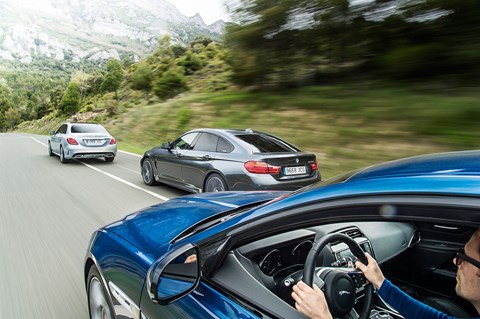
The BMW also uses the ZF 8HP ’box, but seems to deliver a bigger thunk to the back when each ratio comes on line. It’s the only car here to offer anything resembling a normal automatic gearshifter: the XE gets Jag’s now-familiar rotary controller, and the Mercedes a column-shifter that frees up useful storage space on the console (unless you go for the more conventionally presented six-speed manual).
A column shift doesn’t sound or look like sports saloon material, but that’s just one example of how Mercedes has confidently asserted its own agenda, after previously slavishly following BMW’s. Body motions are well controlled and the fast 2.1-turns variable-ratio steering rack imbues the C-class with a surprising pointiness, but never at the expense of sophistication or stability. This can do the twisty stuff with ease, but it’s not massively engaging. Task it with a high speed A-road run though, and that’s where it shows its mettle.
Ride and handling
The 420d is different. Rawer, more feelsome, less comfortable, it doesn’t deal with surface imperfections anything like as well, but keys you into that surface better. There’s less understeer in the fat-tyred BMW and more opportunity to experience the traditional sensations of a rear-drive chassis. No-one really turns the ESP off in these cars, much like no-one drives their new Lambo at 202mph, the difference between C220 and 420 being that you actually can in the BMW, and you might want to.
The Jag complies too; at least to demands to deactivate the ESP, though the grip/grunt ratio is skewed in favour of the rubber so if you want to make tyre fires you’ll need the 335bhp XE S – or the XE R if you’ve got the patience to wait a year or two. But what even this humble diesel does show is that there’s more to a great driver’s car than that. A beautifully sweet chassis balance and a fantastically supple ride mean every mile and every road is a good one in the Jag.
Hairpins highlight the slower steering at the extremes of lock, which demands an extra wrist twist compared to the C220, but it’s misleading. It’s the XE and not the C-class that’s the most agile, the keenest to turn. And even if the Brit’s first electric steering system on a Jaguar saloon car doesn’t sparkle with the same textural detail as the company’s best hydraulic systems, it’s supremely accurate, perfectly weighted and delivers more feel than the overdamped Merc’s. If only you could actually get your mitts round the rim. The fat spokes don’t allow it, leaving you feeling as if you’ve got the stumpy-fingered hands of a cartoon cat.
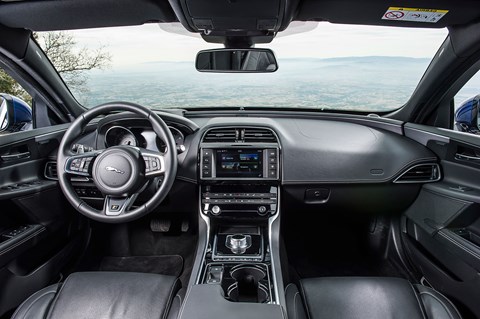
The Jag plays out exactly as you’d hope, offering most of the C-class’s refinement, but without its sense of detachment, and absolutely without the compromises in refinement the BMW demands. Because the 420d’s lively dynamics and performance advantage result in refinement that’d make a Victorian stevedore ashamed. Whether idling or powering through the gears, the BMW is rowdier than a young Clint Eastwood in a blue-collar suburban wine-lodge, and neither rides as well, or eliminates steering kickback so effectively as the Mercedes. It’s the same story when it comes to road and wind noise. The BMW transmits too much of both, the Benz is better, and the Jag’s sole demerits are a rustle around the wing mirrors and a shudder at start-up that engineers found could only be cured at the expense of some steering feel. Too high a price, they decided. If you agree, then the refinement concerns we raised after driving the Ingenium-powered XE prototype back in January are no longer valid. This is a very cultured car.
Sadly some of the build quality niggles we highlighted haven’t disappeared since then. The dashboard – like the exterior, handsomely conservative – looks and feels good enough, the new touchscreen multimedia system seems broadly intuitive, and the F-type-referencing twin-gauge instrument cluster reinforces the sports bit, and not the saloon. The upper dash surface wraps neatly into the door panels, but it’s what happens when it gets there that disappoints. The ugly plastic speaker grille looks like something out of a 20-year-old Mazda, and the recess carved out for use as a door pull is like a plastic Barbie bath. It doesn’t look or feel remotely like something belonging on a premium car, and neither does the sharp edge on the external door frame moulding that scratches your hand when you push the door closed.
Cabin fever: the interior battleground
The BMW’s dash feels a little low-rent in places too, particularly around the centre stack, but has the excuse that the 3-series cabin – which the 4-series rather disappointingly cribs wholesale – was first revealed back in 2012. It’s a testament to how quickly things change in the industry that what looked fresh and felt posh only a few years ago is already showing its age. The new C-class just fast-tracked that process. Look close and it’s clear that the C-class isn’t actually as nicely constructed as the S-class limo whose spirit it’s trying to channel. How could it be at less than half the price? But this is still a genuinely draw-dropping cabin: modern, airy and stylish, spoiled only by the dated-looking chunky frame on the iPad-style (but not touchscreen) display. Even the exterior door handles ooze a luxury feel with their fluid, low-effort action. The new Audi A4 due later this year is going to have to do something pretty incredible to top quality like this (and there’s no chance of the 2015 3-series facelift besting it either).
None of these cars is huge in the back, but there’s no doubting that despite the longest wheelbase here, the back of the Jag is the most cramped. It feels tighter for headroom and narrow, too. Curiously though, the rear bench is the nicest shaped and the most comfortable of the lot, while the Merc’s tapering rear side-window-line actually makes it feel claustrophobic. Kidnap victims will be better off in the boot, which is bigger than the Jag’s and the same size as the BMW’s, although the 4-series’ tailgate makes it easier to access.

Whether that, and the sexier styling makes the Gran Coupe worth a £3720 premium over an equivalent 3-series is a matter of opinion. You can get into a GC for just over £30k, and a (much slower, more meanly equipped) 3-series for £5k less, the cheapest XE splitting them down the middle. The 197bhp 2.0 petrol XE SE costs £26,990, undercutting the cheapest C-class by £280, and then kicking it in the teeth with standard sat-nav, 17in wheels, dual-zone climate and an eight-speed auto.
But what matters here are leasing rates and CO2 figures. Jag proudly trumpets the greenest XE’s impressive 99g/km, but that only applies to the basic 161bhp diesel with a manual ’box. Our 178bhp R-Sport’s 111g/km bumps it into the next company car tax band compared with the German pair, though the effect on your pay packet is negligible. Whether you’re choosing as a company car or leasing privately, of these three cars in these trims, the Mercedes is the cheapest to run, and the BMW the most expensive, though there’s no harm in letting the neighbours presume the contrary when they clock that three-pointed star on your drive.
Verdict
Seldom are giant test verdicts so tough to call. Let’s not pretend this is any kind of walkover for the XE because the opposition is too tough for that. But the BMW, exciting as it is to drive, does fall first, and not merely because of the Gran Coupe’s price disadvantage. Had we thrown in a 3-series it would have suffered from the same debilitating lack of refinement that relegates this 4-series to third place. These are sports saloons, but they’re also meant to be miniature luxury machines and the 4’s uncouth engine and poor road noise suppression doesn’t cut it.
The Jaguar and Mercedes are harder to split – not because they’re so close in character, but because they’re so different. For many buyers, for casual car fans and your company’s accountant, the C-class is unarguably the better car. It oozes class, it’s got the best interior, it’s brilliantly refined and yes, it even handles tidily. For the Jag to win despite its slightly tighter packaging and occasional quality foibles, it’d have to be brilliant to drive and we’d have to really care that it was. Fortunately, it is and we do. If the BMW’s athleticism comes at the expense of luxury, the reverse is true of the Mercedes. It’s a brilliant car, but one lacking a little dynamic sparkle in the face of the XE, a car whose chassis doesn’t make you choose between luxury and performance, and whose other qualities are close enough to the Merc’s for us to accept as penance. It’s tight, but in the battle of the sports saloons, only the Brit really feels like one, and that’s why for us, the Jaguar XE wins.
Read on for CAR magazine’s technical spec analysis of the three sports saloons.
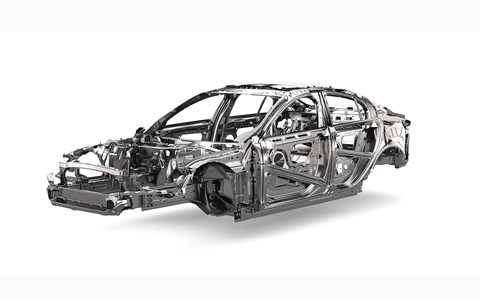
Key tech: Jaguar XE aluminum chassis
Jaguar is justifiably proud of the XE’s bonded and riveted aluminium chassis, the only aluminium structure in the class. It’s made possible because the XE shares the technology with the also completely new XF. There are big benefits over steel in terms of rigidity, but the news is not all positive. The chunkier structures aluminium construction requires impact on cabin space, and our test XE weighed just 5kg less than the steel C-class. But the rear-biased distribution of the few steel components – all four doors, the bootlid and the boot floor – helps create a perfect 50:50 weight distribution that contributes to the XE’s excellent handling balance. A key benefit in this company.

Key tech: Mercedes C-class air suspension
The C-class doesn’t just look like big brother S-class, you can spec limo tech like air-sprung suspension. Steel springs are standard but £895 swaps them for the Airmatic Agility Package on the Sport and AMG Line models, combining air springs and adaptive dampers. Toggling the Agility Select mode fitted to all Cs will then tweak the chassis set-up. You can manually raise it 25mm to increase ground clearance, and it will automatically lower itself 15mm from default height to cut drag and improve handling at speed.
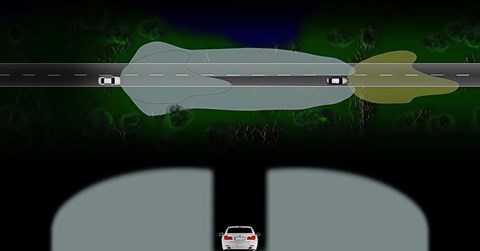
Key tech: BMW 4-series adaptive lights
BMW’s options list is a bigger risk to your wealth than a Vegas casino holiday, but if you’re going to choose one thing, make it the £360 adaptive headlights. The 420d M Sport comes with xenons but the adaptive package adds a cornering function and a brilliant full-beam assistant that uses a camera to recognise cars both oncoming and ahead in your lane. Instead of dipping the lights, it maintains high beam, but blocks out the portion of the light that might dazzle other drivers. Useful and clever.